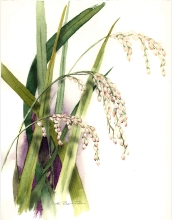News Release 05-134
International Team Maps Rice Genome
Genetic sequence of world’s most important crop holds promise for the growing human population
August 10, 2005
This material is available primarily for archival purposes. Telephone numbers or other contact information may be out of date; please see current contact information at media contacts.
Researchers with the International Rice Genome Sequencing Project (IRGSP) have published the "finished" DNA blueprint for a crop that feeds over half of the people in the world. Analysis of the rice genome, reported in the Aug. 11 issue of the journal Nature, revealed the location and sequence of over 37,500 protein-encoding genes in 389 million bases of DNA.
Rice now holds the distinction of being the first crop plant whose genome has been sequenced. Scientists around the world will use the wealth of new information in efforts to improve yields in not only rice, but also in other closely related grass crops such as barley, corn, rye, sugarcane and wheat.
"Knowing the sequence of one of the world's most important crops, will be invaluable to plant genomics researchers. This project will potentially help millions of people around the globe," said National Science Foundation (NSF) Director, Arden L. Bement, Jr.
The IRGSP used the japonica subspecies of rice, which is cultivated in Japan, Korea and the United States. The group made public a draft sequence of the japonica genome in late 2002. Since then, IRGSP scientists have increased the quality of the sequence to 95 percent complete at greater than 99 percent accuracy. By comparison, the 3 billion-base-pair human genome, with its 25,000 genes, reached that quality level in 2004, some 3 years after its draft sequence was completed.
Formally established in 1998, the Japanese-led, IRGSP consortium also includes the United States, China, Taiwan, Korea, India, Thailand, France, Brazil and the United Kingdom.
"This is a monumental achievement. Enough credit cannot be given to the IRGSP members for working together to advance the research of such an important world crop," said Mary Clutter, assistant director for NSF's biology directorate.
Estimates predict that world rice production must increase by 30 percent in the next 20 years to keep pace with the growing world population. Thus, maximizing rice yields is particularly crucial now, as worldwide environmental degradation has caused decreased rice production for the past 4 years.
Rice plants also provide more than just food. Grain is fermented into wine. Rice straw makes cattle feed, paper, rope and bricks. Rice oil goes into soap and cosmetics, and seed hulls provide fuel for simple stoves and packing material for fragile cargo. Even the ash from the hulls is useful--it cleans discolored teeth!
The U.S. National Plant Genome Initiative coordinated the U.S. component of the project. The U.S. Department of Agriculture-Cooperative State Research, Education and Extension Service, the National Science Foundation, the U.S. Department of Energy, and the Rockefeller Foundation provided support for the work.-NSF-
Media Contacts
Richard (Randy) Vines, NSF, (703) 292-7963, email: rvines@nsf.gov
Jennifer Martin, USDA-CSREES, (202) 720-8188, email: jmartin@CSREES.USDA.GOV
Jeff Sherwood, DOE, (202) 586-4826, email: Jeff.Sherwood@hq.doe.gov
Program Contacts
Jane Silverthorne, NSF, (703) 292-8470, email: jsilvert@nsf.gov
Related Websites
International Rice Genome Sequencing Project: http://rgp.dna.affrc.go.jp/IRGSP/
The U.S. National Science Foundation propels the nation forward by advancing fundamental research in all fields of science and engineering. NSF supports research and people by providing facilities, instruments and funding to support their ingenuity and sustain the U.S. as a global leader in research and innovation. With a fiscal year 2023 budget of $9.5 billion, NSF funds reach all 50 states through grants to nearly 2,000 colleges, universities and institutions. Each year, NSF receives more than 40,000 competitive proposals and makes about 11,000 new awards. Those awards include support for cooperative research with industry, Arctic and Antarctic research and operations, and U.S. participation in international scientific efforts.
Connect with us online
NSF website: nsf.gov
NSF News: nsf.gov/news
For News Media: nsf.gov/news/newsroom
Statistics: nsf.gov/statistics/
Awards database: nsf.gov/awardsearch/
Follow us on social
Twitter: twitter.com/NSF
Facebook: facebook.com/US.NSF
Instagram: instagram.com/nsfgov



